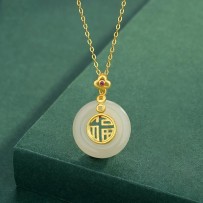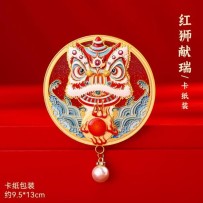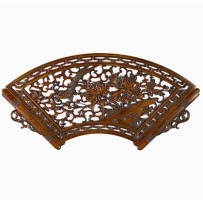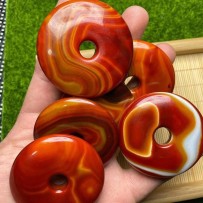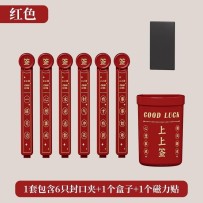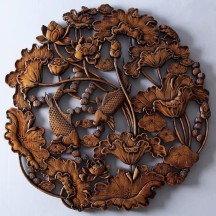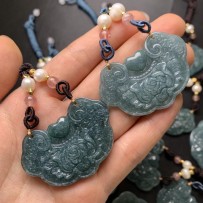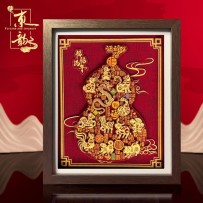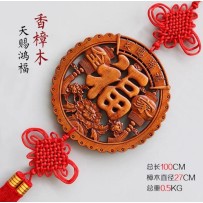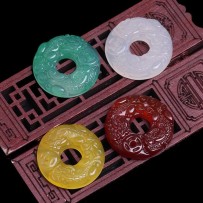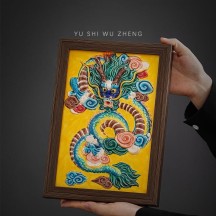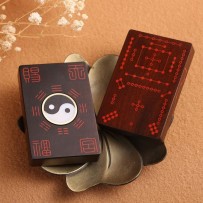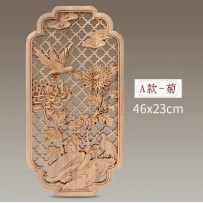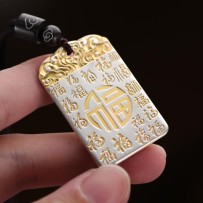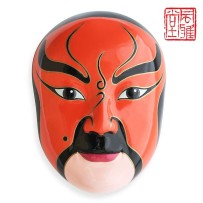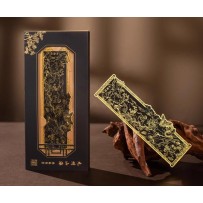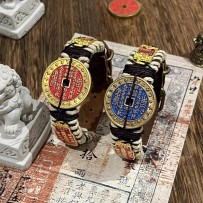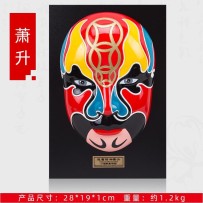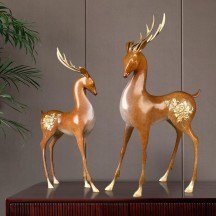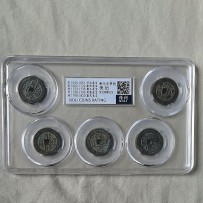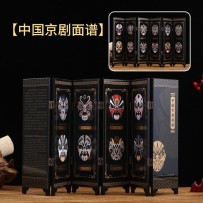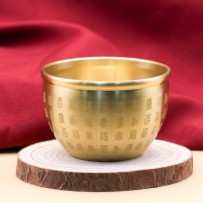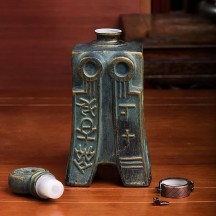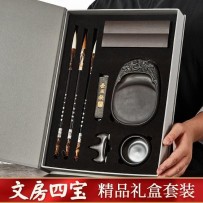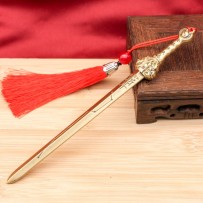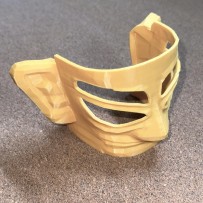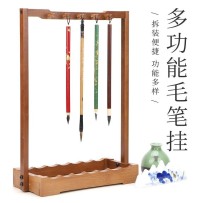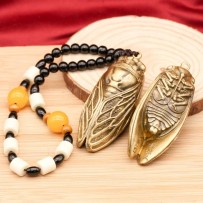Ping An Kou is a traditional Chinese jade ornament. It is round and flexible in appearance, which conforms to the "doctrine of the mean" in traditional Chinese culture. In ancient times, it was called "Bi" and has the effect of nourishing the body. In modern times, it is often given to lovers, relatives, and friends as a gift to wish for peace.
Subcategories
Active filters
Fridge magnets are small yet delightful cultural and creative products. They serve not only as decorative items but also as carriers of travel memories, expressions of emotion, and even conveyors of cultural messages.
Dongyang woodcarving mainly features flat relief, and is characterized by multi-layered relief and scattered perspective composition. Carvers employ techniques such as thin relief, low relief, deep relief, high relief, and multi-layer layering to create works that are rich in layers yet dynamic, with smooth and natural lines, enabling them to vividly present various patterns on camphor wood.
Ping An Kou is a traditional Chinese jade ornament. It is round and flexible in appearance, which conforms to the "doctrine of the mean" in traditional Chinese culture. In ancient times, it was called "Bi" and has the effect of nourishing the body. In modern times, it is often given to lovers, relatives, and friends as a gift to wish for peace.
The meaning of a "fortune slip" refers to the act of drawing a message to predict the future or seek insight into good or bad fortune—essentially a form of divination. It is often seen as a symbol of hope, offering spiritual comfort in times of difficulty, and can also serve as a way to relax and lighten one’s mood.
Dongyang woodcarving mainly features flat relief, and is characterized by multi-layered relief and scattered perspective composition. Carvers employ techniques such as thin relief, low relief, deep relief, high relief, and multi-layer layering to create works that are rich in layers yet dynamic, with smooth and natural lines, enabling them to vividly present various patterns on camphor wood.
The patterns on jade pendants are extremely delicate and varied, and through the patterns, we can understand the rich cultural connotations, production techniques, and social and economic environment of the time.
This product is inspired by the "gourd," which serves as the central design element. Combined with meaningful text, it incorporates characteristics and customs of traditional Chinese festivals to create a joyful and harmonious festive atmosphere. The overall design features a golden color scheme, symbolizing prosperity and good fortune. It creatively integrates hollowed three-dimensional imagery with traditional paper-cutting, a form of intangible cultural heritage, resulting in a unique and artistic decorative piece.
Dongyang woodcarving mainly features flat relief, and is characterized by multi-layered relief and scattered perspective composition. Carvers employ techniques such as thin relief, low relief, deep relief, high relief, and multi-layer layering to create works that are rich in layers yet dynamic, with smooth and natural lines, enabling them to vividly present various patterns on camphor wood.
Ping An Kou is a traditional Chinese jade ornament. It is round and flexible in appearance, which conforms to the "doctrine of the mean" in traditional Chinese culture. In ancient times, it was called "Bi" and has the effect of nourishing the body. In modern times, it is often given to lovers, relatives, and friends as a gift to wish for peace.
Among the Four Divine Beasts, the Azure Dragon holds significant symbolic meaning and cultural value. It represents power and authority, protection and blessings, morality and wisdom, as well as cultural heritage and a sense of national pride.
Dongyang woodcarving mainly features flat relief, and is characterized by multi-layered relief and scattered perspective composition. Carvers employ techniques such as thin relief, low relief, deep relief, high relief, and multi-layer layering to create works that are rich in layers yet dynamic, with smooth and natural lines, enabling them to vividly present various patterns on camphor wood.
The Hetu and Luoshu are two mysterious patterns handed down from ancient China. They contain profound principles of the universe and astrology and are known as the "Magic Cube of the Universe". They are the source of Chinese culture, Yin-Yang and the Five Elements. The phrase comes from the Book of Changes, "The Hetu and the Luoshu". He refers to the Yellow River. Luo refers to the Luo River.
Chinese fan culture carries a profound cultural heritage and is an integral part of the nation's traditions. Beyond being used for cooling, fans also serve as props in dance and stage performances, symbolizing friendship and connection. They make thoughtful gifts for friends, family, and international guests. Today, fan decorations are increasingly found in homes and have gradually evolved into objects of artistic appreciation, greatly enhancing their cultural and aesthetic value.
Dongyang woodcarving mainly features flat relief, and is characterized by multi-layered relief and scattered perspective composition. Carvers employ techniques such as thin relief, low relief, deep relief, high relief, and multi-layer layering to create works that are rich in layers yet dynamic, with smooth and natural lines, enabling them to vividly present various patterns on camphor wood.
The Peaceful and Trouble-free plaque is a type of jade pendant. Because the entire jade plaque is not carved, there is a saying in the jade industry that things without any carvings are called "nothing", so the jade plaque borrows the meaning of "peaceful and trouble-free". "Peaceful and Trouble-free" means peace and everything goes well.
Facial makeup in Peking Opera is a decorative art form that combines dots, lines, shapes, and colors in an organic way. With vibrant hues, elegant designs, and exaggerated stylization, it vividly and expressively portrays the appearance and personality traits of theatrical characters. This art form reflects the aesthetic creativity and cultural spirit of the Chinese people.
The talisman money is a Taoist prayer object. These coins are cast with patterns of the Eight Diagrams, immortals, Taishang Laojun, and the God of Thunder. The mountain ghost flower money is a carrier used by Taoist priests in the Qing Dynasty to cast spells to subdue demons and exorcise ghosts. It can also be called a magic tool. After being consecrated by Taoist priests, people are requested to hang it in their homes or carry it with them to ensure safety.
Facial makeup in Peking Opera is a decorative art form that combines dots, lines, shapes, and colors in an organic way. With vibrant hues, elegant designs, and exaggerated stylization, it vividly and expressively portrays the appearance and personality traits of theatrical characters. This art form reflects the aesthetic creativity and cultural spirit of the Chinese people.
Deer are noble, elegant, gentle and mysterious animals with upright postures.They are a good choice for displaying at home or giving as gifts.
The Five Emperors' Coins refer to five round copper coins with square holes, which symbolize the power of the five elements and the five directions, and have the function of warding off evil spirits and bringing good fortune. The saying that the five emperors minted coins is mostly fabricated by later generations. People call the coins issued by several dynasties the Great Five Emperors' Coins. The Great Five Emperors' Coins are made of bronze, including the Qin Banliang, the Han Wuzhu, the Tang Kaiyuan Tongbao, the Song Yuan Tongbao, and the Ming Yongle Tongbao.
Facial makeup in Peking Opera is a decorative art form that combines dots, lines, shapes, and colors in an organic way. With vibrant hues, elegant designs, and exaggerated stylization, it vividly and expressively portrays the appearance and personality traits of theatrical characters. This art form reflects the aesthetic creativity and cultural spirit of the Chinese people.
Because of its legendary meaning of attracting wealth and its function of receiving money, the cornucopia is listed as an important Feng Shui ornament for attracting wealth, along with the "golden toad" and "lucky cat". In China, especially among the Han people in the south of the Yangtze River, the cornucopia is a treasure for guarding the house.
The early forms of ancient coins were mainly shellfish. In China, from the late primitive society to the Xia, Shang and Zhou dynasties, the main form of currency was physical currency, and the most widely circulated was natural shellfish. Later, a small amount of metal weighing currency and coins appeared.
The Four Treasures of the Study—paper, brush, ink, and inkstone—are traditional Chinese tools for writing and painting. They have made remarkable contributions to the promotion of Chinese culture and the advancement of global civilization. Even today, they continue to play an important role.
Since ancient times, Taoists have used the "QiXing Sword" as a magical instrument for rituals, and even as a treasure to guard their sects. At that time, Buddhism and Taoism were both powerful, and both advocated the rise of martial arts. Therefore, Buddhism and Taoism greatly promoted the vigorous development of Chinese martial arts.
Sanxingdui culture can be traced back to the Xia and Shang dynasties, about 3,000 to 5,000 years ago.
The unearthed masks, especially the "bulging-eyed bronze statue" (also known as the "bronze man mask") with abnormally protruding eyeballs, show the uniqueness and mystery of the ancient Shu civilization
Based on the appearance of the Sanxingdui bronze man mask, this 3D printed model basically reproduces the details and unique shape of the original mask.
It cannot be guaranteed to be completely consistent with the unearthed original, so it is only used as a display of space ornaments such as office desks, entertainment and leisure, and national style displays.
A brush hanger is a tool used to suspend brushes from a rack, while a brush rest—also known as a "brush mountain" or "brush holder"—is primarily used to rest brushes when not in use. These rests come in a variety of materials and are often shaped like mountains.
The ancients believed that the cicada was far away from the ground, lonely and proud, not eating worldly food, only drinking dew, and was a symbol of nobility.










